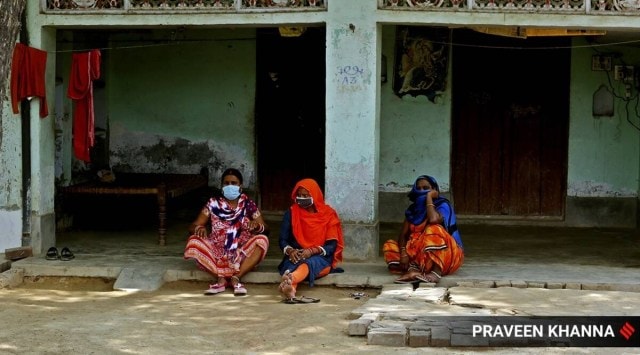Harikishan Sharma, Senior Assistant Editor at The Indian Express' National Bureau, specializes in reporting on governance, policy, and data. He covers the Prime Minister’s Office and pivotal central ministries, such as the Ministry of Agriculture & Farmers’ Welfare, Ministry of Cooperation, Ministry of Consumer Affairs, Food and Public Distribution, Ministry of Rural Development, and Ministry of Jal Shakti. His work primarily revolves around reporting and policy analysis. In addition to this, he authors a weekly column titled "STATE-ISTICALLY SPEAKING," which is prominently featured on The Indian Express website. In this column, he immerses readers in narratives deeply rooted in socio-economic, political, and electoral data, providing insightful perspectives on these critical aspects of governance and society. ... Read More
Rs 54,487 crore for PMAY-Gramin: Highest ever outlay to spur asset creation
Apart from being one of the drivers of capital expenditure in rural areas, the scheme has yielded political dividends to the ruling BJP-led National Democratic Alliance in polls across states in recent years.
 The PMAY-Gramin is one of the schemes that plays a crucial role in asset creation in rural areas. (Express File Photo)
The PMAY-Gramin is one of the schemes that plays a crucial role in asset creation in rural areas. (Express File Photo) In a big push to rural infrastructure, the government has allocated Rs 54,487 crore for its flagship rural housing scheme—Pradhan Mantri Awaas Yojana-Gramin—for financial year 2023-24, which is the highest ever allocation since the inception of the scheme in 2016. Besides, an allocation of Rs 70,000 crore has been made for Jal Jeevan Mission, a scheme aimed at providing tap water connections to rural households.
In her budget speech, Finance Minister Nirmala Sitharaman said, “The outlay for PM Awaas Yojana is being enhanced by 66 per cent to over Rs 79,000 crore.”
The details available in the budget documents shows that out of Rs 79,000 crore allocated for the PMAY (Rural & Urban both), an amount of Rs 54,487 crore has been earmarked for the PMAY-Gramin.

The allocation of Rs 54,487 crore for the PMAY-Gramin is 172 per cent higher as compared to the allocation of Rs 20,000 crore in 2022-23. It is even higher than the Revised Estimates of Rs 48,422 crore for the year 2022-23. Of the allocation of Rs 54,487 crore, an amount of Rs 50,486.99 crore has been allocated for the programme component, while an amount of Rs 4,000 crore has been provided for interest payment to NABARD for EBR [Extra Budgetary Resources] loans.
The PMAY-Gramin is one of the schemes that plays a crucial role in asset creation in rural areas. It also gives a boost to the construction activities in villages and creates demand for building materials like cement and steel. The government had set a target of construction of 2.95 crore houses till 2024, out of which, 2.15 crore have been constructed till date. The figure is expected to reach 2.35 crore by the end of the current financial year (2022-23). In the next financial year, the Centre aims to construct 58 lakh houses under the scheme.
Apart from being one of the drivers of capital expenditure in rural areas, the scheme has yielded political dividends to the ruling BJP-led National Democratic Alliance in polls across states in recent years. This is the reason the government has not hesitated in allocating a big amount to the scheme. In 2022-23 fiscal, the government had used its emergency funds to top up the scheme allocation, as about 84 per cent of budgetary allocation was used in just seven months (April-October). After the Rural Development Ministry flagged the shortage of the funds, the government had approved an advance of Rs 13,000 crore for the rural housing scheme from the Contingency Fund of India. Later, the government allocated Rs 28,422 crore in the first Supplementary Demands for Grants during the winter session of Parliament.

Housing for all by 2024
Each beneficiary gets funds up to Rs 1.2 lakh in the plains and from Rs 75,000-Rs 1.30 lakh in hilly states, difficult areas, and tribal and backward districts under the Integrated Action Plan (IAP). The funds are to be split in a 60:40 ratio between the Centre and states, respectively, with the target of constructing 2.95 crore houses by March 2024.
The PMAY-Gramin’s allocation (Rs 54,487 crore) for 2023-24 is the highest ever since the scheme was launched in 2016 after the erstwhile Indira Awas Yojana (IAY) was restructured to provide ‘housing for all’ by 2022. However, later the deadline was extended to 2024.
The PMAY-Gramin generates employment both directly and indirectly. Generally, the labour component in a house construction is about 25 per cent, said a source at the Ministry of Rural Development. The source said that about 440.72 crore ‘unskilled person days’ have been generated under the PMAY-Gramin and the erstwhile IAY. The source further said that in addition to direct employment, indirect employment has also been created under the PMAY-Gramin.
The PMAY-Gramin aims to provide ‘pucca’ houses with a minimum area of 25 sq m with basic amenities to people in rural areas who are homeless or live in ‘kutcha’ and dilapidated houses. For construction of one PMAY-Gramin house of 25 sq mt (267 sq ft), on an average, require 9,000 bricks, 110 cement bags, 750kg steel, 12 cubic metre (cmt) sand, 40 mm 3 cmt metal, and wood/steel for four doors, four windows, a source said.
In addition to a big jump in the PMAY-Gramin budget, the government has retained the allocation of Pradhan Mantri Gram Sadak Yojna (PMGSY) at Rs 19,000 crore for financial year 2023-24. After NREGS and PMAY-Gramin, the PMGSY is the third biggest scheme of the Rural Development Ministry.
The higher allocation for the PMAY-Gramin and maintaining the allocation of PMGSY at the last year’s level is significant in view of the government focus on capital expenditure.
The government has allocated Rs 70,000 crore for Jal Jeevan Mission, which is higher than the allocation of Rs 60,000 crore made in 2022-23. However, the allocation of Jal Jeevan Mission was reduced to Rs 55,000 crore at the time of RE for the current financial year (2022-23).
Union Budget 2023: All you need to know
- ↗️ Finance Minister Nirmala Sitharaman’s Union Budget 2023 has some big takeaways
- ↗️ First, what everyone has been looking forward to: changes in the new income tax regime. She has made the new tax regime more attractive. There are changes in the rebate limit and in tax slabs. What does this mean for the taxpayer?
- ↗️ FM Sitharaman proposed a 33% increase in capital investment outlay, raising it to Rs 10 lakh crore. This is the biggest in the past decade. What does it mean?
- ↗️ Some articles get cheaper and others get costlier due to changes in customs duty. Here is a list
- ↗️ The capital outlay for the railways has been increased to the highest ever – Rs 2.40 lakh crore. The government is trying to create more jobs
- ↗️ FM Sitharaman said the fiscal deficit will fall to 5.9% of the GDP. What does it mean for the stakeholders?
- ↗️ The FM called it the ‘first Budget of Amrit Kaal’. PM Narendra Modi said it will build a strong foundation for a developed India. What did opposition leaders say?
Photos



- 01
- 02
- 03
- 04
- 05





























